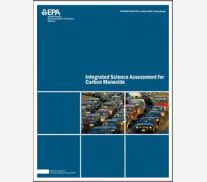Integrated Science Assessment (ISA) for Carbon Monoxide
On this page:
The Issue
Carbon monoxide (CO) is a colorless, odorless gas emitted from combustion processes. Nationally, particularly in urban areas, the majority of CO emissions to ambient air come from mobile sources. CO can cause harmful health effects by reducing oxygen delivery to the body's organs (like the heart and brain) and tissues. At extremely high levels, CO can cause death.
EPA Action
EPA's CO research efforts are focused on improving emissions estimates, determining health and ecological effects, and improving modeling capabilities. The Clean Air Act requires EPA to periodically review the science for six major air pollutants, including CO. EPA's Center for Public Health and Environmental Assessment (formerly National Center for Environmental Assessment) develops Integrated Science Assessments (ISAs) that summarize the science related to the health and ecological effects caused by these pollutants. The ISA for CO is a comprehensive review of the policy-relevant scientific literature published since the last National Ambient Air Quality (NAAQS) review. ISAs provide a comprehensive review of the policy-relevant scientific literature published since the last National Ambient Air Quality (NAAQS) review and in conjunction with other technical assessments, provide the policy-relevant scientific information necessary to conduct a review of the adequacy of the current NAAQS. The last review of the CO NAAQS was completed in 2011, but the Agency chose not to revise the standards at that time.
EPA first set air quality standards for CO in 1971. For protection of both public health and welfare, EPA set an 8-hour primary standard at 9 parts per million (ppm) and a 1-hour primary standard at 35 ppm. In a review of the standards completed in 1985, EPA revoked the secondary standards (for public welfare) due to a lack of evidence of adverse effects on public welfare at or near ambient concentrations. EPA released the Integrated Science Assessment for Carbon Monoxide Final Report in January 2010.
- Learn about the Integrated Science Assessment for Carbon Monoxide (2010)
- Learn about the Carbon Monoxide Air Quality Standards
History of the Carbon Monoxide Assessments
| Date | Milestone |
|---|---|
| Jan 2010 | EPA released the document Integrated Science Assessment for Carbon Monoxide (Final, 2010) (EPA/600/R-09/019F). This is the most recent CO ISA. [Federal Register Jan 29, 2010] |
| Jun 2000 | EPA release the document Air Quality Criteria Document for Carbon Monoxide (Final, 2000) (EPA/600/P-99/001F). |
| Dec 1991 | EPA release the document Air Quality Criteria Document for Carbon Monoxide (Final, 1991) (EPA/600/8-90/045F). |
| Aug 1984 | EPA release the document Revised Evaluation of Health Effects Associated with Carbon Monoxide Exposure: An Addendum to the 1979 EPA Air Quality Criteria Document for Carbon Monoxide (EPA-600/8-83-033F). |
| Oct 1979 | EPA release the document Air Quality Criteria Document for Carbon Monoxide (Final, 1979) (EPA-600/8-79-022). |
| Mar 1970 | The National Air Pollution Control Administration published the first Air Quality Criteria for Carbon Monoxide. |
Peer Reviewed Literature
While working on the assessment of carbon monoxide (2009), EPA used the Health and Environmental Research Online (HERO) database to augment the underlining literature that supported the final assessment.
See: ISA for Carbon Monoxide (2010 Final Project Page)
HERO is a searchable database of more than 1.6 million scientific studies and other references used to develop EPA assessments aimed at understanding the health and environmental effects of pollutants and chemicals.

